Honor Award
The Lawn is Dead – Long Live the Lawn
Mark Simmons, Affiliate ASLA
Lady Bird Johnson Wildflower Center/University of Texas at Austin
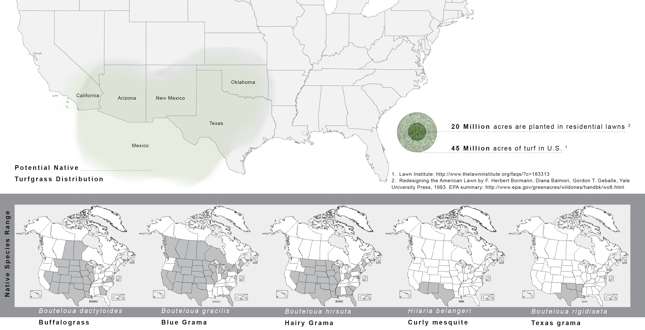 Close Me!
Close Me!Selected for structural similarity to commercial turfgrass (same color, height, leaf blade width etc.) these native grass species have a geographic range across North America. This suggests similar mixes with some species substitutions would be suitable for other regions.
Download Hi-Res ImageImage: Lady Bird Johnson Wildflower Center
Image 1 of 10
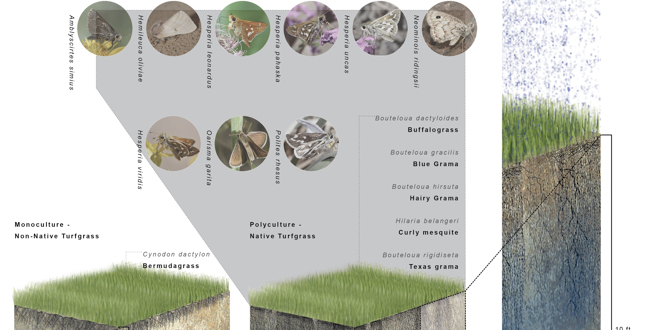 Close Me!
Close Me!Native turf grasses, with deeper root systems, have many ecological benefits: sequestering CO2, increasing water infiltration (flood mitigation | improving water quality), reducing erosion, and providing habitat. These tested grasses are host plants and food sources for several species of butterfly and moth.
Download Hi-Res ImageImage: Lady Bird Johnson Wildflower Center
Image 2 of 10
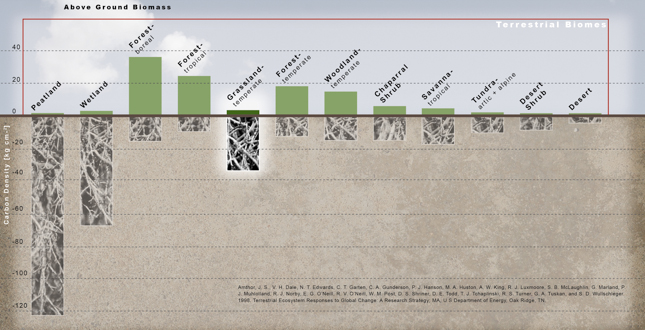 Close Me!
Close Me!Evolved with fire and grazing, native grasses keep most biomass below ground. After wet systems (Peatlands and Wetlands) Grasslands have the highest density of below ground carbon, which, unlike above ground biomass, can sequester carbon for 100,000s of years.
Download Hi-Res ImageImage: Lady Bird Johnson Wildflower Center
Image 3 of 10
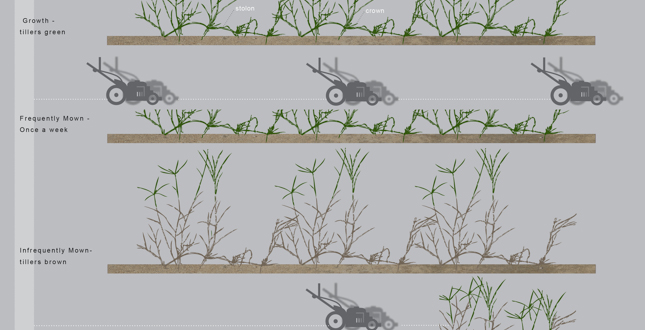 Close Me!
Close Me!Industry standard, common Bermudagrass must be mowed at a higher frequency than the native turf. Left unmown, Bermudagrass branches aerially, shading the tillers below so they become discolored. Mowing ‘scalps' the green canopy revealing unsightly brown tillers below.
Download Hi-Res ImageImage: Lady Bird Johnson Wildflower Center
Image 4 of 10
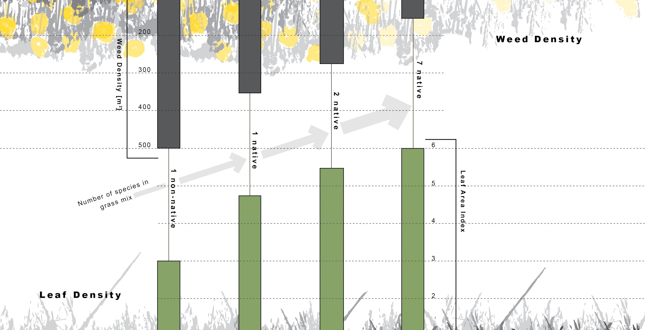 Close Me!
Close Me!This research found the more grass species included in the turf mix the greater the leaf density and the fewer the number of weeds.
Download Hi-Res ImageImage: Dennis Fagan
Image 5 of 10
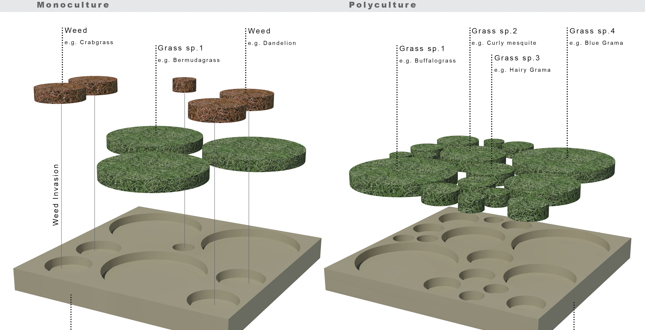 Close Me!
Close Me!A monoculture has a narrow ‘niche volume' and is open to invasion by weeds with different niche dimensions. By contrast, a mix of native grasses, although aesthetically identical, fills a greater volume of niche space and is resilient to invasion.
Download Hi-Res ImageImage: Guy Thompson
Image 6 of 10
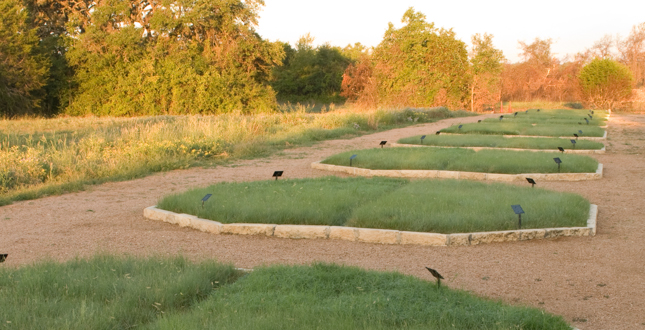 Close Me!
Close Me!The study examined the performance of mixes of seven native grasses against the most commonly used lawn grass in the region. Plots were tested for establishment, weed invasion irrigation and compaction.
Download Hi-Res ImageImage: Lady Bird Johnson Wildflower Center
Image 7 of 10
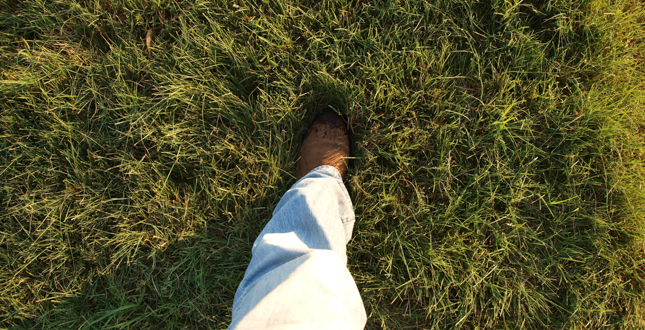 Close Me!
Close Me!The study, open to public demonstration, examines the application of the turf mix for green roofs and the addition of more species to increase horticultural, ecological and sustainable performance.
Download Hi-Res ImageImage: Lady Bird Johnson Wildflower Center
Image 8 of 10
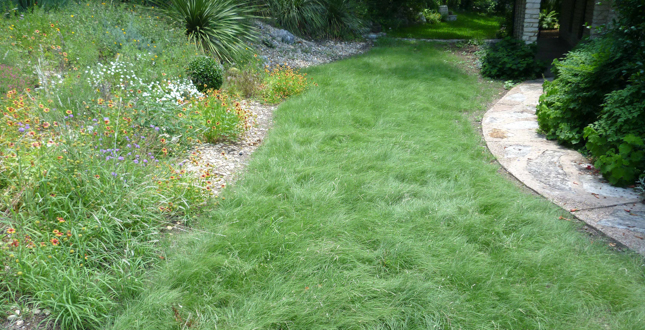 Close Me!
Close Me!Mowed short or long, the native turf has a much softer texture than conventional, non-native monocultures.
Download Hi-Res ImageImage: Lady Bird Johnson Wildflower Center
Image 9 of 10
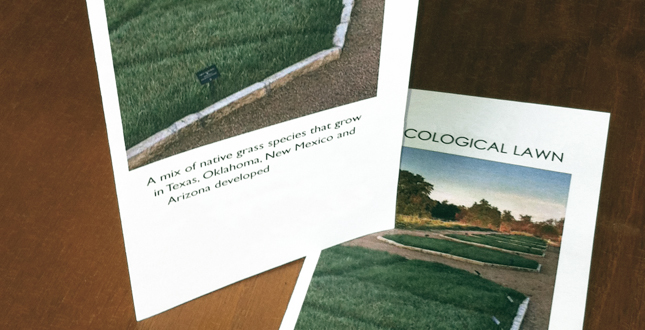 Close Me!
Close Me!The native turf mix is also being used on campuses. Several acres of this turf have been installed at the George W Bush Presidential Center in Dallas, where left unmowed, the grasses form a sustainable turf with attractive seed heads.
Download Hi-Res ImageImage: Lady Bird Johnson Wildflower Center
Image 10 of 10
Project Statement
Turf is widely used in urban landscapes, but is frequently criticized due to high demand for water, fertilizer, pesticides and mowing. This research assessed a turf mix derived from regionally-native turfgrass species and determined that it established faster, had higher leaf density, fewer weeds and required less mowing than a common non-native turf. A similar ecological design approach to turf design elsewhere would have a profound effect on the environmental footprint of all turf landscapes.
Project Narrative
—2013 Professional Awards Jury
Problem
Turfgrasses are a dominant urban and sub-urban landscape type contributing to roadsides, parks, campuses, golf courses, utility rights-of-way, and residential lawns. These landscapes, however, are justifiably villainized due to their high demand for water, fertilizer, pesticides and mowing. Fifty million acres of turfgrasses in both commercial and residential applications represent the primary irrigated crop in the United States, absorbing up between 30% and 60% of potable urban water. Lawns alone annually consume 67 million pounds of pesticides, 70 million tons of fertilizer, as well as 300 million gallons of gasoline producing 5% of the nation's air pollutants. The resource dependence of this landscape type over the last 40 years has been the direct result of the development of cheap fertilizer and pesticides, breeding of nutrient-dependent grasses and the availability of water. The result is an industrial landscape that has become neither environmentally responsible nor economically viable.
Solution
Given the highly desirable aesthetic of this landscape type, we questioned the suitability of species selection and performance of the conventional monocultural non-native turfgrasses. Could a suite of naturally occurring, coexisting, turfgrass species with identical leaf appearance, not only meet the aesthetic and performance expectations, but also, result in the reduction of environmental costs in terms of resource consumption and maintenance requirements? So a series of replicated test plots were designed to assess and compare establishment rates, leaf density, compaction disturbance, and weed infestation of a standard non-native turfgrass, against naturally occurring suites of regionally-native seed mixes. The data demonstrated that native turfgrasses established faster, had higher leaf density, fewer weeds and required less mowing than the conventionally turfgrass. This supports the hypothesis that ecologically-stable native turfgrass communities adapted to the low nutrient soils and regional climatic conditions are better, or at least, as-well suited, as commercial turfgrass species. This has beneficial implications not only from the perspective of lower maintenance needs and reduced environmental risk, but also for biodiversity value, resource requirements and carbon footprint of all turfgrass landscapes.
Conclusion and Next Steps
This turfgrass mix is already available commercially and is being implemented on residential and large commercial landscapes. But this research does not stop here. We are currently proposing to the network of public gardens around the nation to replicate this technology regionally. The adoption of similar ecological design protocols to turfgrass elsewhere could have a significant positive effect on sustainability and environmental footprint of all urban landscapes.
This research project presentation demonstrates:
- Distributions and characteristics of selected species
- Benefits of an ecologically designed turf
- Disadvantage of the commonly-used non-native turfgrass monoculture
- Weed resistance of the multi-species turf and the underling ecological theory
- Large scale application examples
- Residential application examples
- Public outreach
Project Resources
Design & Contruction Team
Lead Designer
Mark Simmons, Affiliate ASLA
Additional Project Credits
Michelle Bright, Assoc. ASLA
Michelle Bertelsen
Steve Windhager
Holly Zafian
Emily Manderson, ASLA
Matthew O'Toole
John Hart Asher




